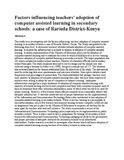| dc.description.abstract | This study is an investigation into the factors influencing teachers' adoption of computer assisted learning in secondary schools, a case of Rarieda District, Kenya. The Study was guided by the following objectives: to determine teachers' attitudes towards adoption of computer assisted learning; to explore the infrastructure in schools in relation to adoption of computer assisted learning; to assess implementation of the Ministry of Education policy on the adoption of computer assisted learning and to establish the extent to which availability of in service training influence adoption of computer assisted learning in secondary schools.
The target population was 261 which included secondary school teachers, Ministry of education officials and secondary school Principals. The study employed descriptive survey design and the sample size was collected using a formula by Fisher et al (1998), this gave a sample size of 155. The literature was reviewed based on the themes established from the objectives of the study. The instruments used for collecting data were questionnaire and interview schedule. Descriptive statistics used frequencies and percentages to present data.
The study established that younger teachers were more positive to adoption of computer assisted learning than older 'teachers while majority of teachers were willing to adopt the use of computers to enhance learning. Inadequate infrastructure emerged as a major hindrance to adoption of computer assisted learning with majority of schools lacking electricity and computers and those with computers acquired most of them as donations from other education stakeholders, Some of which were too old to be used for proper learning. However, a few schools which offered computer as an examinable subject had adequate infrastructure.
It was also noted that lack of proper assessment on the implementation of the Information and Communication Technology Policy also contributed to low adoption of computer assisted learning in secondary schools. While in-service training is a prerequisite to successful adoption, only a few teachers had acquired training on basic computer certificate and no programme was put in place by the Ministry of Education to empower all teachers for the same apart for teachers who took self initiative.
The study recommends a review of the Information and Communication Technology policy especially on its implementation in public secondary school. There is also a need to have a programme for training all secondary. school teachers on Information and Communication Technology pedagogical skills by the government and proper provision of adequate resources for secondary schools by all educational stakeholders. Further research is needed to investigate other factors which influence adoption of computer assisted learning among teachers of secondary schools in urban areas. | en_US |

